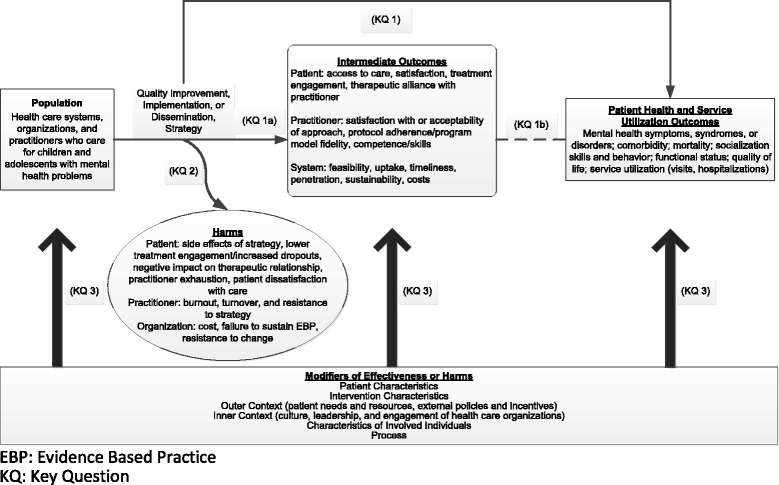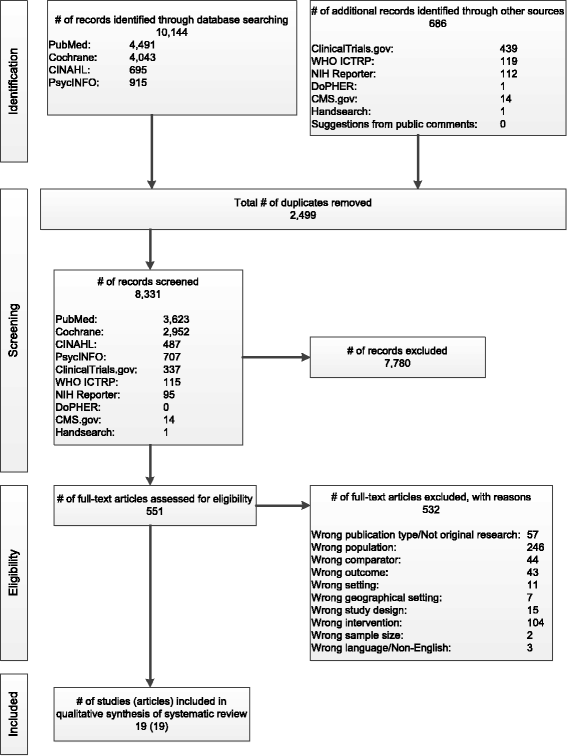Quality improvement, implementation, and dissemination strategies to improve mental health care for children and adolescents: a systematic review
- PMID: 28738821
- PMCID: PMC5525230
- DOI: 10.1186/s13012-017-0626-4
Quality improvement, implementation, and dissemination strategies to improve mental health care for children and adolescents: a systematic review
Abstract
Background: Some outcomes for children with mental health problems remain suboptimal because of poor access to care and the failure of systems and providers to adopt established quality improvement strategies and interventions with proven effectiveness. This review had three goals: (1) assess the effectiveness of quality improvement, implementation, and dissemination strategies intended to improve the mental health care of children and adolescents; (2) examine harms associated with these strategies; and (3) determine whether effectiveness or harms differ for subgroups based on system, organizational, practitioner, or patient characteristics.
Methods: Sources included MEDLINE®, the Cochrane Library, PsycINFO, and CINAHL, from database inception through February 17, 2017. Additional sources included gray literature, additional studies from reference lists, and technical experts. Two reviewers selected relevant randomized controlled trials (RCTs) and observational studies, extracted data, and assessed risk of bias. Dual analysis, synthesis, and grading of the strength of evidence for each outcome followed for studies meeting inclusion criteria. We also used qualitative comparative analysis to examine relationships between combinations of strategy components and improvements in outcomes.
Results: We identified 18 strategies described in 19 studies. Eleven strategies significantly improved at least one measure of intermediate outcomes, final health outcomes, or resource use. Moderate strength of evidence (from one RCT) supported using provider financial incentives such as pay for performance to improve the competence with which practitioners can implement evidence-based practices (EBPs). We found inconsistent evidence involving strategies with educational meetings, materials, and outreach; programs appeared to be successful in combination with reminders or providing practitioners with newly collected clinical information. We also found low strength of evidence for no benefit for initiatives that included only educational materials or meetings (or both), or only educational materials and outreach components. Evidence was insufficient to draw conclusions on harms and moderators of interventions.
Conclusions: Several strategies can improve both intermediate and final health outcomes and resource use. This complex and heterogeneous body of evidence does not permit us to have a high degree of confidence about the efficacy of any one strategy because we generally found only a single study testing each strategy.
Trial registration: PROSPERO, CRD42015024759 .
Keywords: Adolescents; Children; Dissemination; Evidence-based medicine; Implementation; Mental health; Quality improvement; Systematic review.
Conflict of interest statement
Ethics approval and consent to participate
N/A
Consent for publication
N/A
Competing interests
The authors declare that they have no competing interests.
Publisher’s Note
Springer Nature remains neutral with regard to jurisdictional claims in published maps and institutional affiliations.
Figures



References
-
- O'Connell ME, Boat T, Warner KE, editors. Preventing mental, emotional, and behavioral disorders among young people: progress and possibilities. Washington, DC: National Academies Press; 2009. - PubMed
-
- Perou R, Bitsko RH, Blumberg SJ, Pastor P, Ghandour RM, Gfroerer JC, et al. Mental health surveillance among children—United States, 2005–2011. MMWR Surveill Summ. 2013;62(Suppl 2):1–35. - PubMed
Publication types
MeSH terms
Grants and funding
LinkOut - more resources
Full Text Sources
Other Literature Sources
Medical

